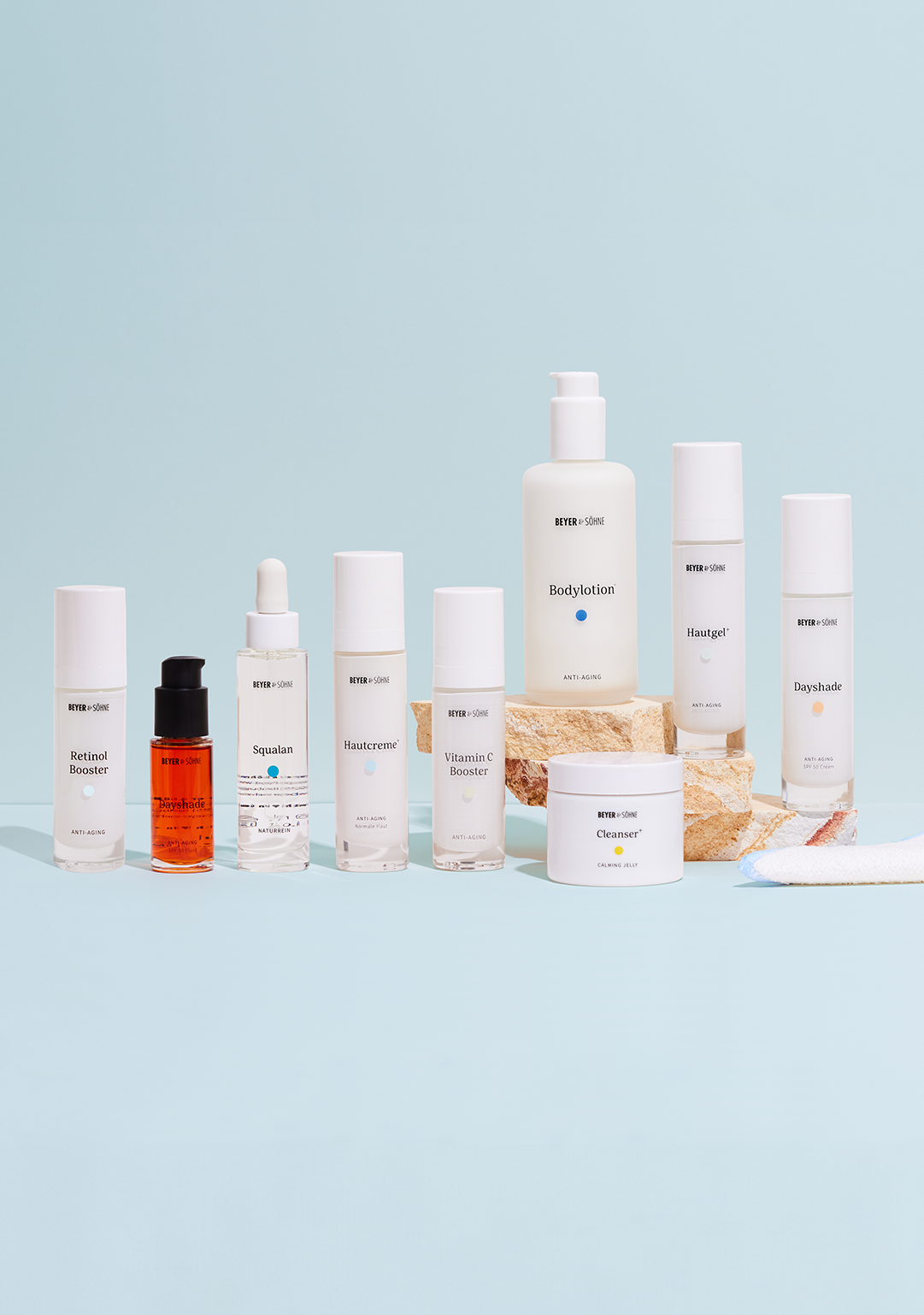Deep Impact
Retinol: Is Vitamin A the Key to Combating Skin Aging?
Retinol stands as a well-known powerhouse in the realm of anti-aging – and for good reason! It not only diminishes wrinkles but also aids in fortifying the skin's structure while acting as an antioxidant against free radicals. However, it's important to note that incorporating Retinol into your skincare routine may come with some side effects. In this article, you'll discover the various forms of Retinol and how it optimally interacts with the skin.

Nico Beyer
October 2024
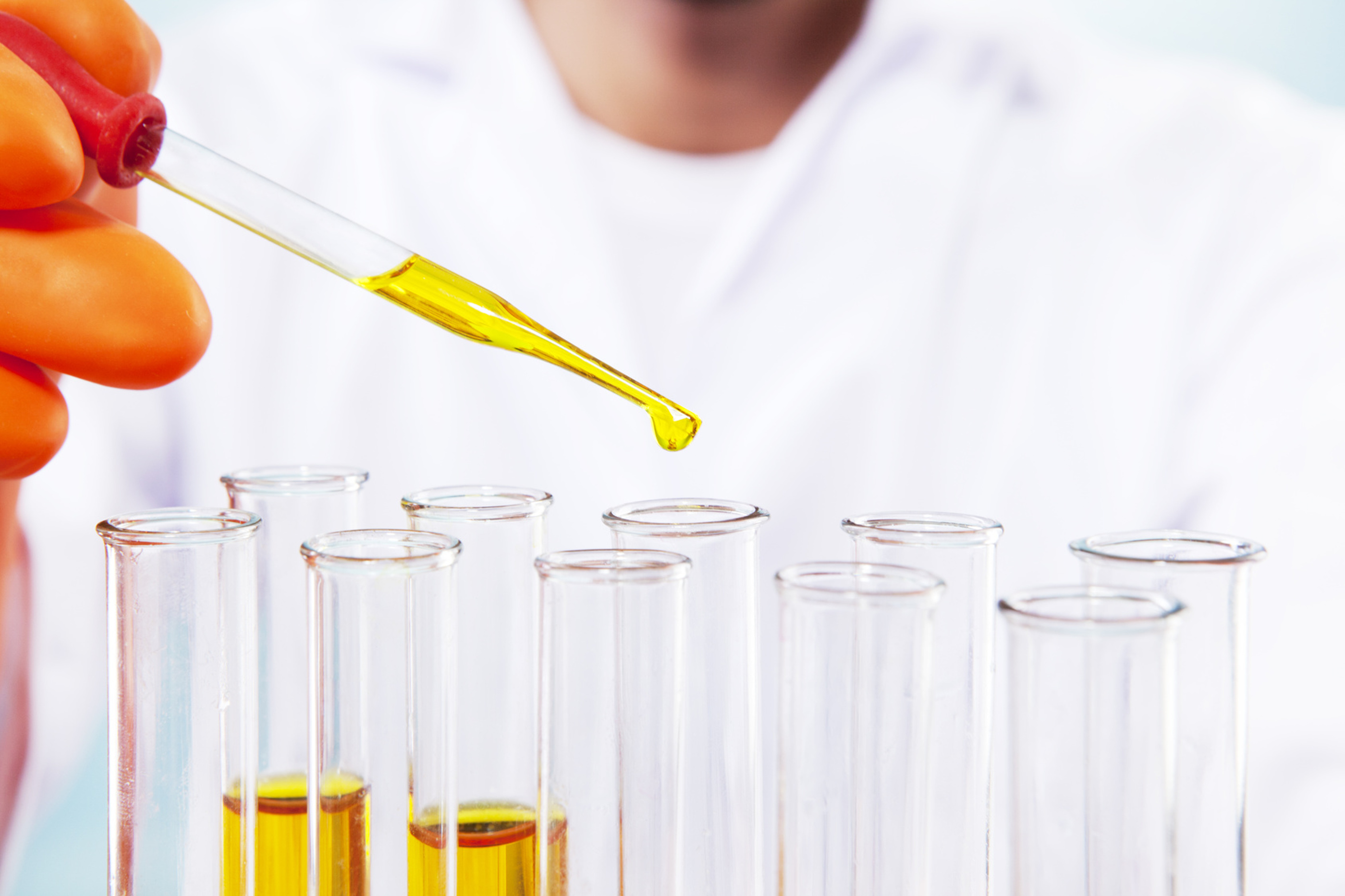
Table of Contents
How Can Retinol Benefit Your Skin?
What is Retinol, and How Does it Work?
Retinol: Protection as an Antioxidant
Retinal, Tretinoin & Co: What Forms of Retinol Exist?
What is the Best Form of Retinol?
The Microdosing Principle
"More is More" principle
What Retinol Dosage is Best for the Skin?
Well-Tolerated Vitamin A Forms
The Pharmacist Knows: The Mix Makes the Difference!
Anti-Aging: These Additional Ingredients Help
Are There Alternatives to Retinol?
Is Retinol Safe?
Retinol Creams: Absorption through the Skin?
Retinol and Sun Exposure
Retinol in summer: Is it advisable?
Every Ingredient Counts!
Conclusion
How Can Retinol Benefit Your Skin?
For years, Retinol has been a stalwart presence in anti-aging cosmetics, with numerous studies showcasing its positive impact on the skin's appearance. The groundbreaking revelation:
Retinol can genuinely reduce wrinkles
. And that's not all:
1.
Retinol supports the construction of the skin's structure,
2.
refines pores and aids in combating acne,
3.
and acts as a potent antioxidant against free radicals.
What is Retinol, and How Does it Work?
Retinol stands out as a highly effective form of Vitamin A, playing a crucial role in structuring the skin. The outermost layer of the skin is composed of horn cells (corneocytes), and Vitamin A promotes the formation of these cells while assisting in the skin's regeneration process. This results in a skin-enhancing effect and visibly smoother skin.
Bonus Feature: As Retinol stimulates the production of healthy skin cells and regulates cellular functions, it can also prove effective against acne.
In the deeper layers of the skin, collagen forms the framework. A robust collagen framework ensures that the skin remains supple and flexible, leading to fewer fine lines. Retinol stimulates collagen production, ensuring a fresh, stable framework and consequently reducing the depth of wrinkles.
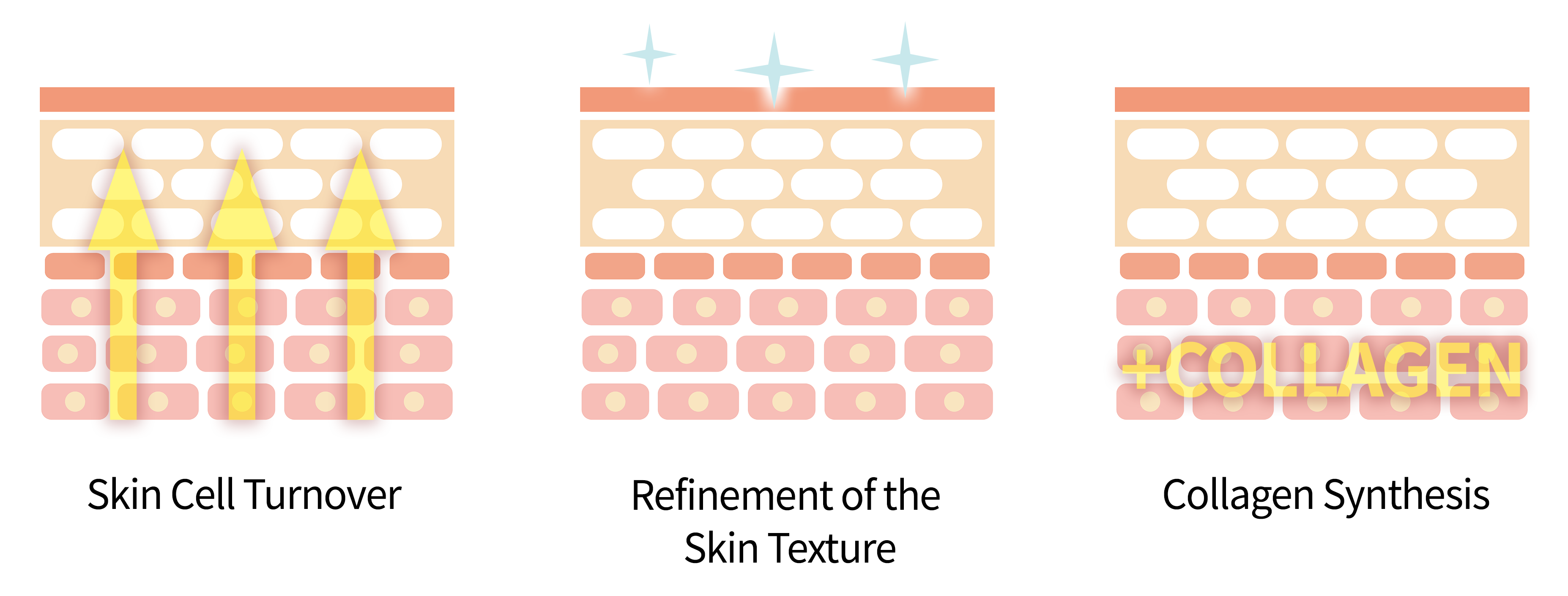
This is how Retinol operates within the skin: It promotes skin renewal, refines the texture of the skin, and stimulates collagen synthesis in the deeper layers of the skin.
Retinol: Protection as an Antioxidant
Moreover, Vitamin A serves as a potent antioxidant, safeguarding the body against free radicals. You've likely heard of these troublemakers before—free radicals, those unstable molecules that wreak havoc in the body, damaging cells and contributing to premature skin aging and wrinkles.
Antioxidants act as "capturers" of free radicals and should be a staple in every anti-aging cream. In addition to Vitamin A, there are many other proven antioxidants like Vitamin C, Vitamin E, Q10, or Resveratrol.
Pro tip:
Antioxidants often work synergistically, meaning they are more effective when used together. Therefore, when choosing an anti-wrinkle cream, it's advisable not to focus solely on one active ingredient.
Retinal, Tretinoin & Co: What Forms of Retinol Exist?
One can distinguish between different forms of retinol.
1.
Retinol Esters
2.
Retinol
3.
Retinal
4.
Retinoic Acid Esters
5.
Retinoic Acid
There are
precursor forms of retinol
called retinol esters. There is
pure retinol
, the classic in anti-aging cosmetics. There is
retinal
, also known as retinaldehyde. Retinal is considered more potent and less irritating. And there is
tretinoin
, which is the active form of retinoic acid. In the skin, retinol esters are converted into retinol. From retinol, retinal is then formed, and ultimately, tretinoin.
Although retinol is well-known, there is still a lot of confusion about its various forms. In the following, we will explain in more detail what this is all about.
1. Retinol-Ester (INCI
Retinyl Palmitate
,
Retinyl Linoleate
, oftmals inkorrekterweise als
Retinol Palmitate
bzw.
Linoleate
bezeichnet)
Dabei handelt es sich um Retinol-Vorstufen, die in der Haut erst einmal durch chemische Reaktionen in Retinol umgewandelt werden. Da diese Stoffe inaktive Formen des Retinols darstellen, sind sie weniger potent, aber gerade deswegen auch milder zur Haut. Gerade bei Retinol gilt: so wenig wie möglich, so viel wie nötig! Denn zu viel Retinol kann zu Entzündungen führen, Rötungen oder brennende Haut verursachen. Gerade die zarte Haut um die Augen kann sehr empfindlich reagieren. Retinol-Ester sind eine sanfte Alternative.
2. Retinol (INCI
Retinol
)
Pure Retinol must oxidize in the skin to become Retinal (Retinaldehyde) and eventually Tretinoin (Retinoic Acid). The active form of Retinol is Tretinoin. In the EU, pure Retinol is typically used at concentrations up to 1% (not the commonly claimed 0.3% in pharmacies). Remember: the lower the concentration, the less irritating.
3. Retinal (INCI
Retinal)
Retinal, also known as Retinaldehyde, is a step further in the conversion process compared to pure Retinol. It delivers a more potent effect while being less irritating. As a rule of thumb: 0.01% Retinal is as potent as 0.1% Retinol.
4. Retinoic Acid Esters (INCI
Retinyl Retinoate, Sodium Retinoyl Hyaluronate, Granactive Retinol, or Hydroxypinacolone Retinoate
)
Relatively new in skincare, these are esters of pure Retinoic Acid, meaning Retinoic Acid is combined with another substance, making it less irritating. For example, Retinoic Acid can be esterified with Hyaluronic Acid (INCI Sodium Retinoyl Hyaluronate), combining their skincare benefits. Retinoic Acid esters are particularly intriguing when combined with Retinol or Retinal.
5. Tretinoin (Retinoic Acid)
Tretinoin is the active form of Retinoic Acid, also known as Vitamin A Acid. While this retinoid naturally occurs in the human body, it's present in very small quantities. When topically applied, it's extremely irritating. Consequently, there are no cosmetic products with pure Tretinoin. This ingredient is only found in prescription medications for acne, available exclusively at pharmacies.
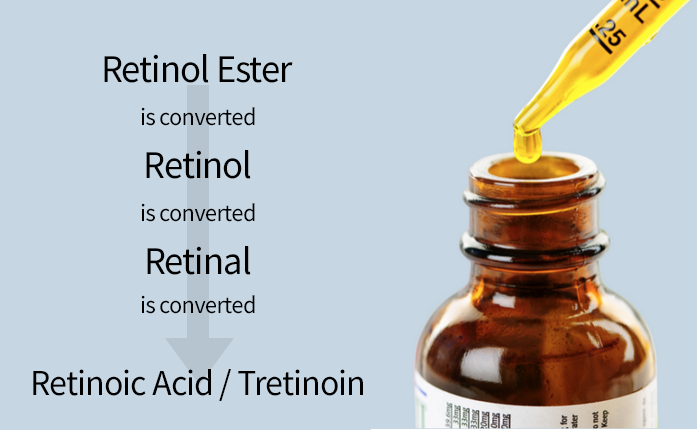
Types of retinol in our skin
What is the Best Form of Retinol?
Answering this question is challenging, as individual tolerances and skin types vary. Therefore, we have adopted two different approaches in our product line.
The Microdosing Principle
For those who wish to avoid inflammatory reactions and prefer a straightforward approach, the Microdosing Principle is the way to go. This approach involves using low doses of the retinyl ester 'Retinyl Palmitate' for daily, gentle skincare. This method excludes irritations while continuously and gently stimulating collagen synthesis. Our skin cream contains 0.2% Retinyl Palmitate.
It is often claimed that Retinol esters are too weak or even useless. This is not true. This study demonstrates that Retinyl Palmitate effectively repairs signs of skin aging, even in moderate concentrations.
"More is More" principle
Our Retinol Booster relies on two different forms of highly concentrated Retinol. It includes 0.1% Retinol, 0.06% Retinal, and a Retinoic Acid Ester at 0.1%. This provides the skin with a substantial amount of Vitamin A. This quantity should be slowly integrated into your skincare routine. You can find all application instructions for the Retinol Booster on our product page.
What Retinol Dosage is Best for the Skin?
This question is frequently asked, and there's no one-size-fits-all answer. Especially with Retinol, the rule of thumb is: every skin is different, so it's best to approach it cautiously until you discover your individual "Retinol threshold."
When it comes to products with pure Retinol, it's advisable to gradually acclimate to higher concentrations. This works well, for example, with the well-tolerated dosage of 0.3%. With prolonged use, you can then progress to 0.5% or even Retinol products with 1%.
Exercise caution when experimenting with the sensitive eye area. By the way, you can find additional tips for effective eye care in this article.
A quick tip: Many "Retinol creams" on popular online marketplaces do not contain pure Retinol. Therefore, look for the word Retinol in the ingredients or inquire with the manufacturer about the form and concentration present.
Well-Tolerated Vitamin A Forms
There are now Retinol and Vitamin A forms that are more tolerable than pure Retinol, allowing for higher dosages with fewer side effects.
In our Retinol Booster, we utilize two well-tolerated Vitamin A forms, enabling the use of high concentrations while minimizing side effects.
Liposomally Encapsulated Retinol
Encapsulated Retinol is encapsulated in small carrier molecules made of phospholipids. This allows it to release its effects more gently (time-release) and reach deeper layers of the skin.
Retinal
Considered more tolerable and effective than pure Retinol, it can also be encapsulated.
The Pharmacist Knows: The Mix Makes the Difference!
The skin is a complex organ where various metabolic processes occur simultaneously. Therefore, we often emphasize the following statement:
There is no one miracle ingredient.
Numerous active ingredients help combat wrinkles. In addition to antioxidants, moisturizers, and membrane lipids are especially essential.
Our aim is to provide the skin with everything it needs to function ideally and remain naturally beautiful. At Beyer & Söhne, we offer an anti-aging complex that relies on the combination of various active ingredients. As beneficial as Vitamin A is, it alone cannot address all aging processes.
There is an abundance of effective anti-aging ingredients. The following substances can enhance the positive effects of Retinol. Many of them work synergistically. Therefore, one should not limit oneself to a high dose of a single substance. A combination of different active ingredients will always yield the best results.
Anti-Aging: These Additional Ingredients Help
Three classics from anti-aging medicine are Vitamin C, Vitamin E, and Q10. Vitamin C plays a crucial role in collagen production. Vitamin E supports the fight against free radicals. Combining them with Q10 enhances the effectiveness against skin aging and oxidative stress.
There are also new substances from nature. Resveratrol protects the skin from environmental influences. Astaxanthin is considered the world's strongest antioxidant, safeguarding the skin from aging and UV radiation.
Furthermore, there are skin-native lipids and moisturizers such as Hyaluronic Acid, Ceramides, and Phosphatidylcholine. Hyaluronic acid retains moisture in the skin, ceramides are natural building blocks of our skin, and phosphatidylcholine initiates a natural skin renewal process. This process is notably gentler than a peel with high-dose Retinol, but it takes a bit longer.
Are There Alternatives to Retinol?
There are numerous compounds with proven anti-aging effects. However, as an alternative to pure Retinol, we particularly recommend Vitamin C. It also has a skin-refining effect and strengthens the collagen structure.
Furthermore, Vitamin C acts as an antioxidant against free radicals. In our Skin Gel+, we use 4% gentle Vitamin C, Hyaluronic Acid, and other ingredients in serum concentration.
Another substance with a gentle, skin-renewing effect is Phosphatidylcholine. This is a membrane lipid and a natural component of every cell in the body. It supports skin renewal in a gentle manner, making it suitable for sensitive skin. This article provides insights into how Phosphatidylcholine works in the skin.
Bakuchiol is also gaining popularity. It is a plant-derived substance initially isolated from the Psoralea corylifolia plant. Although it does not belong to the group of retinoids due to its structure, Bakuchiol exerts similar effects. For this reason, it is referred to as a functional retinoid analog.
Is Bakuchiol as Effective as Retinol?
Bakuchiol has only been used in cosmetic products for a short time, resulting in a limited body of research. Bakuchiol is often compared to Retinol and is claimed to be equally effective with better tolerability. However, the lack of decades-long experience that exists with Retinol makes Bakuchiol an interesting molecule that should be further investigated in the future. Currently, we cannot recommend it as the ultimate replacement for Retinol.
Is Retinol Safe?
Retinol in cosmetic products has been a well-established ingredient for decades, known not only for its high efficacy but also for its safety. However, what risks and side effects can skincare products with Retinol pose?
A Vitamin A hypervitaminosis (overdose) can indeed carry health risks and dangers, ranging from mild headaches to severe fetal malformations. It's important to note that Retinol in creams and skincare is not comparable to Retinol from foods, supplements, and medications.
Retinol Creams: Absorption through the Skin?
The amount of Retinol absorbed from cosmetics into the systemic circulation is very small. Therefore, an overdose from a Retinol cream with an appropriate concentration is highly unlikely. Nevertheless, for safety reasons, we recommend applying pure Retinol only to the face. Treating the entire body significantly increases the absorption rate.
For safety reasons, pregnant individuals should avoid Retinol creams. However, this does not apply to Retinyl Palmitate, a gentle derivative. It is only converted into Retinol as needed and is therefore safe in appropriate doses. In general, we recommend moderately concentrated Retinol cosmetics to avoid harmful skin irritations and reactions.
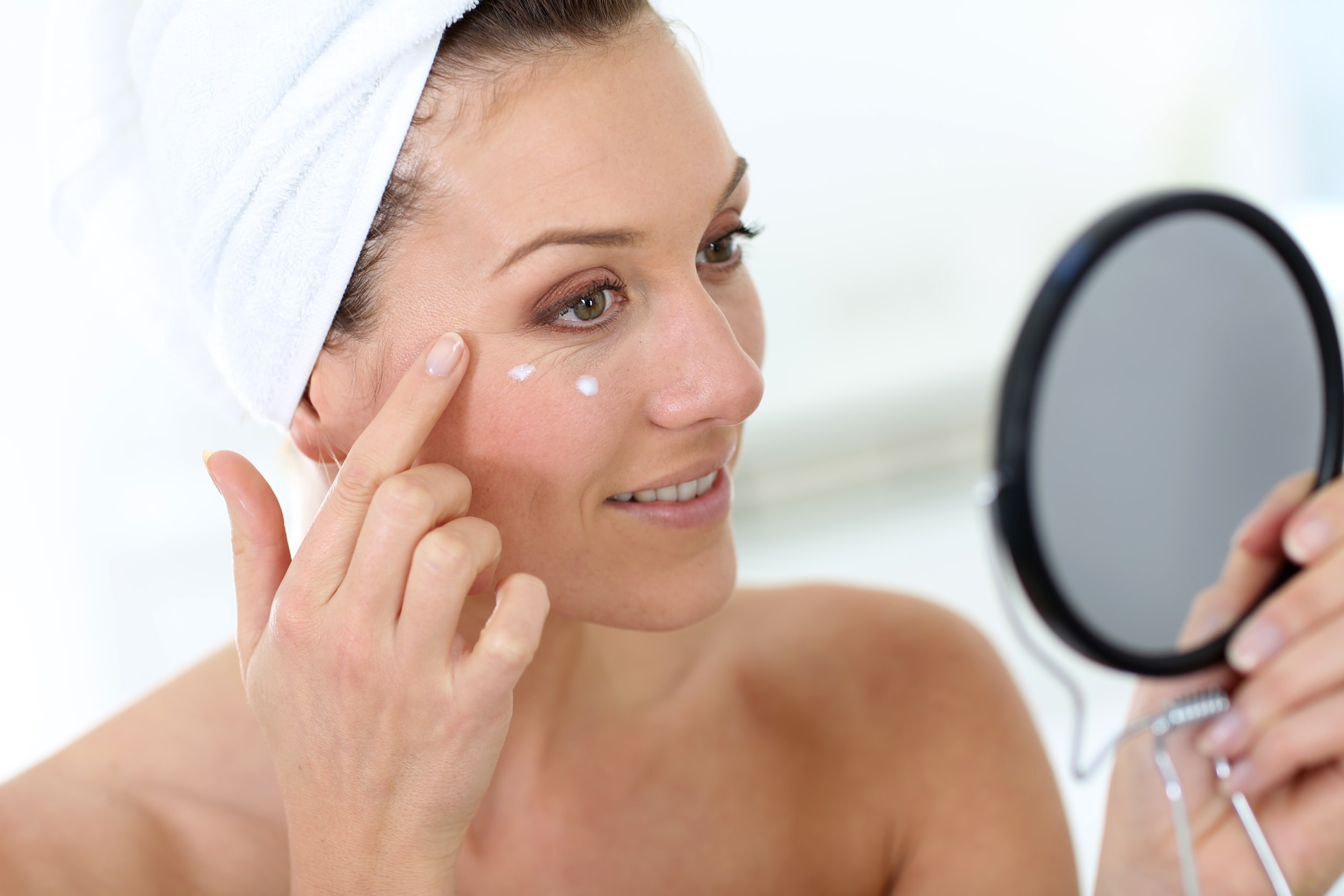
Pure Retinol can potentially irritate the delicate skin around the eyes. It's advisable to opt for a gentler derivative, such as Retinyl Palmitate, for this area.
Retinol and Sun Exposure
Retinol and its derivatives stimulate collagen synthesis in the deep layers of the skin, resulting in smoother, healthier, and stronger skin. Simultaneously, the top layers of the skin, composed of dead cells, are renewed.
This is a desired effect, ensuring that the skin surface consists of new, healthy cells. However, the dead cell layers on the skin surface also provide a natural sun barrier. Therefore, the risk of sunburn is slightly increased when using Retinol.
Retinol in summer: Is it advisable?
You can use your Retinol products throughout the year. Pay special attention to sun protection, especially in the summer. Prolonged sunbathing should be avoided.
For those spending a lot of time in the sun, protection through textiles (clothing, sun hat, sunglasses) and suitable sunscreen is essential. Our Dayshade Cream with high UVA protection and SPF 30, as well as the Dayshade Fluid with SPF 50 and red antioxidants, are ideal for this purpose.
Every Ingredient Counts!
For us, there are no compromises. That's why not only the active ingredients matter in the right skincare; we also have to pay attention to other components. The crucial question is: Are the ingredients good for the skin? Checking the package labels (the INCI) can often be overwhelming. That's why, for our Skin Cream+, we explain each individual ingredient in detail. By the way, we use a well-tolerated dose of Retinyl Palmitate.
Additionally, it is essential to consider whether the cream base is suitable for transporting active ingredients into the skin. A cream with a mineral oil base is usually less suitable because the foreign fats tend to stay on the surface and do not integrate into the skin's natural lipid layers.
By using natural fat sources (such as shea butter, neutral oil, and ceramides) and a cream based on pure phosphatidylcholine, we come much closer to the natural structure of the skin. This creates a natural delivery system for vitamins and other active ingredients. The right cream base with skin-native fatty acids can significantly improve the effective absorption of Vitamin A.
Conclusion
Retinol has a positive impact on the appearance of the skin. It supports the formation of corneocytes and promotes long-term collagen production. This helps combat wrinkle formation and can be effective against acne. For those looking to avoid irritations and side effects, opting for tolerable Retinol esters, like the ones we use in our Skin Cream+, is recommended. For those experimenting with pure Retinol, we suggest not exceeding a concentration of 0.5%.
In any case, keep in mind that holistic anti-aging does not depend on a single ingredient. The full anti-aging effect unfolds in combination with other active ingredients and the right cream base.
Read more about insights from anti-aging medicine in this article.
This article was updated in
February 2023
.
Studies and Sources
Study on retinyl palmitate –
The effect of a vitamin A palmitate and antioxidant-containing oil-based moisturizer on photodamaged skin of several body sites.
Study on retinol –
Improvement of naturally aged skin with vitamin A (retinol).
Study on retinol –
Molecular basis of retinol anti-aging properties in naturally aged human skin in viv
